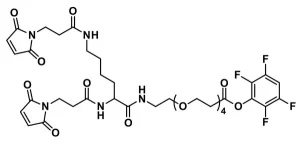Vector Laboratories is closed for the President’s Day on Monday, February 19th. We will be back in the office on Tuesday, February 20th.
We will respond to emails upon our return. Have a wonderful day.
Menu
Vector Laboratories is closed for the President’s Day on Monday, February 19th. We will be back in the office on Tuesday, February 20th.
We will respond to emails upon our return. Have a wonderful day.
SPDP-dPEG®24-NHS ester, product number QBD-10379, is a long (80 atoms), hydrophilic, non-immunogenic, heterobifunctional crosslinker that has the same functionality as the widely popular, but unfortunately hydrophobic, SPDP crosslinker. It contains an amine-reactive N-hydroxysuccinimidyl (NHS) ester on one end of the dPEG®24 linker and a thiol-reactive SPDP (also known as OPSS) reactive group on the other end. The longer spacer arm may facilitate the reaction of the SPDP end of the molecule with buried thiol groups. Moreover, unlike the traditional SPDP crosslinkers, the over-conjugation of proteins or peptides with QBD-10379 will not cause the precipitation of conjugates due to excessive hydrophobicity.
Among the most popular heterobifunctional crosslinking reagents used in bioconjugate chemistry are those compounds that conjugate molecules containing free amine groups with molecules that contain sulfhydryl groups. SPDP (N-succinimidyl 3-(2-pyridyldithio)-propionate) is one of the most popular versions of this type of crosslinker. Unfortunately, SPDP and its popular varieties (LC-SPDP and Sulfo-LC-SPDP) are hydrophobic molecules. When conjugated to biomolecules, care must be taken not to modify the target molecules too much, because this can precipitate the conjugate products.
By contrast, SPDP-dPEG®24-NHS ester, product number QBD-10379, is used like SPDP and its related hydrophobic products. However, precautions against overly modifying the target molecule are not necessary. The water-soluble dPEG® product will not cause the resulting conjugates to precipitate due to excessive hydrophobicity.
| Unit Size | 100 mg, 1000 mg |
|---|---|
| Molecular Weight | 1440.70; single compound |
| Chemical formula | C₆₃H₁₁₃N₃O₂₉S₂ |
| CAS | 924280-65-9 |
| Purity | > 97% |
| Spacers | dPEG® Spacer is 80 atoms and 97.3 Å |
| Shipping | Ambient |
| Typical solubility properties (for additional information contact Customer Support) | Methylene chloride, Acetonitrile, DMAC or DMSO. |
| Storage and handling | -20°C; Always let come to room temperature before opening; be careful to limit exposure to moisture and restore under an inert atmosphere; stock solutions can be prepared with dry solvent and kept for several days (freeze when not in use). dPEG® pegylation compounds are generally hygroscopic and should be treated as such. This will be less noticeable with liquids, but the solids will become tacky and difficult to manipulate, if care is not taken to minimize air exposure. |
Greg T. Hermanson, Bioconjugate Techniques, 2nd Edition, Elsevier Inc., Burlington, MA 01803, April, 2008 (ISBN-13: 978-0-12-370501-3; ISBN-10: 0-12-370501-0); See pp. 276-335 for general description and use of heterobifunctional crosslinkers, and the specific sample protocol for SPDP and LC-SPDP on pp. 286-288. See Greg’s extensive index on pp. 1192-1193 for references to a number and range of applications and their respective protocols.
Greg T. Hermanson, Bioconjugate Techniques, 3rd Edition, Elsevier, Waltham, MA 02451, 2013, ISBN 978-0-12-382239-0; See Chapter 18, Discrete PEG Reagents, pp. 787-821, for a full overview of the dPEG® products.
Different pH-Dependencies of the Two Synaptic Adhesion Molecules N-Cadherin and Cadherin-11 and the Possible Functional Implication for Long-term Potentiation. WERNER BAUMGARTNER, ARMIN OSMANAGIC, MARITA GEBHARD,SANDRA KRAEMER, AND NIKOLA GOLENHOFEN. SYNAPSE. 2013, 67 (10) pp 705-715. June 3, 2013. DOI: 10.1002/syn.21679.
Systemically administered collagen-targeted gold nanoparticles bind to arterial injury following vascular interventions. Molly Wasserman Meyers, Jonathan S Rink, Qun Jiang, Megan E Kelly, Janet M Vercammen, Colby S Thaxton, and Melina R Kibbe. Physiological Reports. 2016, 5 (4): e13128. December 17, 2016. DOI: 10.14814/phy2.13128.
Applicable patents and legal notices are available at legal notices.




Stay in the Loop. Join Our Online Community
Together we breakthroughTM

©Vector Laboratories, Inc. 2024 All Rights Reserved.
How do I Request a Quote?
To request a quote for products: